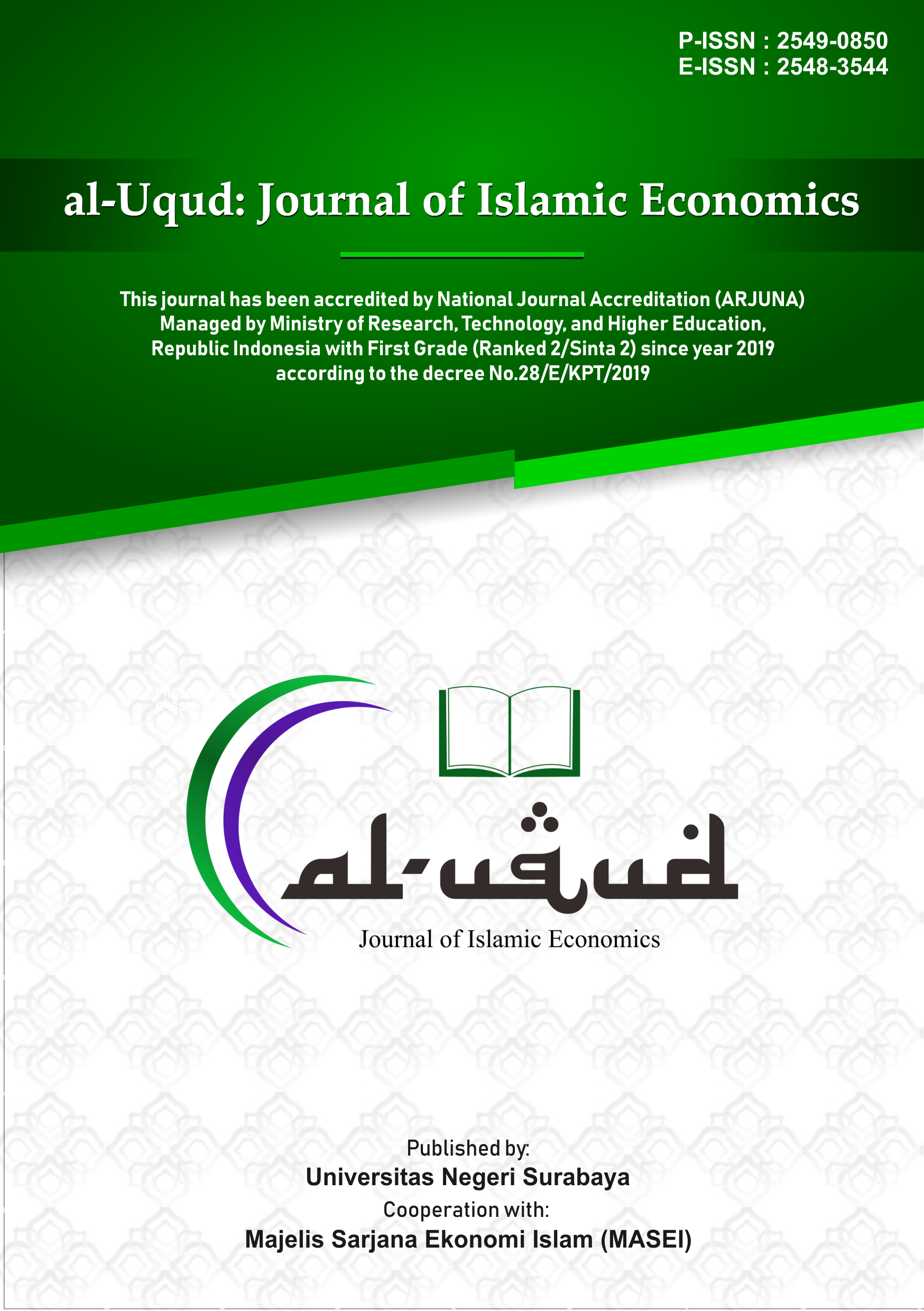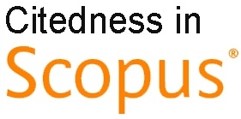Productivity Comparation of Islamic and Conventional Banks in Indonesia
DOI:
https://doi.org/10.26740/al-uqud.v4n1.p69-82Keywords:
Performance, Total factor productivity index, Malmquist productivity index, Islamic banks and conventional banksAbstract
This study aimed to compare the productivity performance of Islamic and Conventional Banks in Indonesia with the Total Factor Productivity Index (TFPCH) indicator. The sample of this study was 14 banks consisting of 7 Islamic Banks and 7 Conventional Banks from 2011-2018. Secondary data were obtained from the annual financial statements of each sample. To measure the total factor productivity index (TFPCH), the Malmquist Productivity Index (MPI) was used as a measure of productivity. It found that the productivity of Conventional Banks was slightly superior compared to Islamic Banks, with contributions from Technical / Technological Change (TECHCH) being the most influential component in the TFPCH composition. Further, there was an indication of a technical increase in both types of banks during the period. The results of this study implied banking industry players to increase their efficiency particularly the usage of technology in providing efficient services to users.
References
Alexakis, C., Izzeldin, M., Johnes, J., & Pappas, V. (2019). Performance and productivity in Islamic and conventional banks: Evidence from the global financial crisis. Economic Modelling, 79, 1-14. https://doi.org/10.1016/j.econmod.2018.09.030
Ariss, R. T. (2010). Competitive conditions in Islamic and conventional banking: A global perspective. Review of Financial Economics, 19 (3), 101-108. https://doi.org/10.1016/j.rfe.2010.03.002
Ascarya, Diana, Yumanita, & Guruh, S. R. (2009). Analisis Efisiensi Perbankan Konvensional dan Perbankan Syariah di Indonesia dengan Data Envelopment Analysis (DEA). Current Issues Lembaga Keuangan Syariah. Prenada Media Group, 1-34.
Bahrini, R. (2015). Productivity of MENA Islamic banks: a bootstrapped Malmquist index approach. International Journal of Islamic and Middle Eastern Finance and Management, 8(4), 508-528. https://doi.org/10.1108/IMEFM-11-2
Beck, T., Demirguc-Kunt, A., & Merrouche, O. (2013). Islamic vs. Conventional banking: Business model, efficiency and stability. Journal of Banking & finance, 37 (2), 433-447. https://doi.org/10.1016/j.jbankfin.2012.09.016
Berger, A. N., & Mester, L. J. (2003). Explaining the dramatic changes in performance of US banks: technological change, deregulation, and dynamic changes in competition. Journal of financial intermediation, 12(1), 57-95. https://doi.org/10.1016/S1042-9573(02)00006-2
Bitar, M., Pukthuanthong, K., & Walker, T. (2019). Efficiency in Islamic vs. conventional banking: The role of capital and liquidity. Global Finance Journal, 100487. https://doi.org/10.1016/j.gfj.2019.100487
Caves, D.W., Christensen, L.R. and Diewert, W.E. (1982), "The Economic Theory of Index Numbers and The Measurment of Input, Output, And Productivity, Econometrica, Vol. 50, pp. 1393-1414. https://www.jstor.org/stable/1913388
Charnes, A., Cooper, W.W. and Rhodes, E. (1978). Measuring the efficiency of decision making units. European Journal of Operations Research 2 (6): 429-44. https://doi.org/10.1016/0377-2217(78)90138-8
Chen, X., Fu, T.-T., Juo, J.-C., & Yu, M.-M. (2019). A comparative analysis of profit inefficiency and productivity convergence between Taiwanese and Chinese banks. BRQ Business Research Quarterly. https://doi.org/10.1016/j.brq.2019.02.001
Coelli, T.J. 1996, A Guide to DEAP Version 2.1: A Data Envelopment Analysis Program, CEPA Working Paper 96/08.
Coelli, T.J., Rao, D.S.P., ODonnell, C.J, and Battese, G.E. (2005), An Introduction to Efficiency and Productivity Analysis, Springer Science and Business Media, New York, NY.
Diaz-Chao, Ã., Sainz-González, J., & Torrent-Sellens, J. (2015). ICT, innovation, and firm productivity: New evidence from small local firms. Journal of Business Research, 68(7), 1439-1444. https://doi.org/10.1016/j.jbusres.2015.01.030
Duygun, M., Sena, V., & Shaban, M. (2016). Trademarking activities and total factor productivity: Some evidence for British banks using a metafrontier approach. Journal of Banking & Finance, 72, S70-S80. https://doi.org/10.1016/j.jbankfin.2016.04.017
Fare, R., S. Grosskopf, B. Lindgren and P. Roos, (1994), Productivity Developments in Swedish Hospital: A Malmquist Output Index Approach, in A. Charnes, W.W. Cooper, A. Lewin and L. Seiford (eds.), Data Envelopment Analysis: Theory, Methodology and Applications, Boston: Kluwer Academic Publishers. https://doi.org/10.1007/978-94-011-0637-5_13
Fisher, I. (1922), The Making of Index Numbers, HoghtonMuflin, Boston, MA.
Grifell-Tatjé, E., & Lovell, C. K. (1995). A note on the Malmquist productivity index. Economics letters, 47(2), 169-175. https://doi.org/10.1016/0165-1765(94)00497-P
Kamarudin, F., Hue, C. Z., Sufian, F., & Mohamad Anwar, N. A. (2017). Does productivity of Islamic banks endure progress or regress? Empirical evidence using data envelopment analysis based Malmquist Productivity Index. Humanomics, 33(1), 84-118. https://doi.org/10.1108/H-08-2016-0059
Koutsomanoli-Filippaki, A., Margaritis, D., & Staikouras, C. (2009). Efficiency and productivity growth in the banking industry of Central and Eastern Europe. Journal of Banking & Finance, 33(3), 557-567. https://doi.org/10.1016/j.jbankfin.2008.09.009
Mansoor Khan, M., & Ishaq Bhatti, M. (2008). Islamic banking and finance: On its way to globalization. Managerial Finance, 34 (10), 708-725. https://doi.org/10.1108/03074350810891029
Mansour, R., & El Moussawi, C. (2019). Efficiency, technical progress and productivity of Arab banks: A non-parametric approach. The Quarterly Review of Economics and Finance. https://doi.org/10.1016/j.qref.2019.02.002
Norma, Saad, M., Shabri Abd. Majid, M., Kassim, S., Hamid, Z., & Yusof, R. M. (2010). A comparative analysis of the performance of conventional and Islamic unit trust companies in Malaysia. International Journal of Managerial Finance, 6(1), 24-47. https://doi.org/10.1108/17439131011015779
Otoritas Jasa Keuangan. (2015). Road Map of Indonesian Islamic Banking 2015 2019. OJK International Conference on Islamic Finance
Otoritas Jasa Keuangan. 2019. Statistik Perbankan Syariah. Jakarta: Otoritas Jasa Keuangan.
Simar, L., & Wilson, P. W. (2019). Central limit theorems and inference for sources of productivity change measured by nonparametric Malmquist indices. European Journal of Operational Research, 277(2), 756-769. https://doi.org/10.1016/j.ejor.2019.02.040
Tornqvist, L. (1936), œThe Bank of Finlands Consumption Price Index, Bank of Finland Monthly Bulletin, Vol. 10, pp. 1-8.
Yaumidin, U.K. 2007, Efficiency in Islamic banking, A non-parametric approach, Buletin Eko
Downloads
Published
How to Cite
Issue
Section
License
CC BY 4.0 Abstract views: 746
,
Abstract views: 746
, PDF Downloads: 546
PDF Downloads: 546








